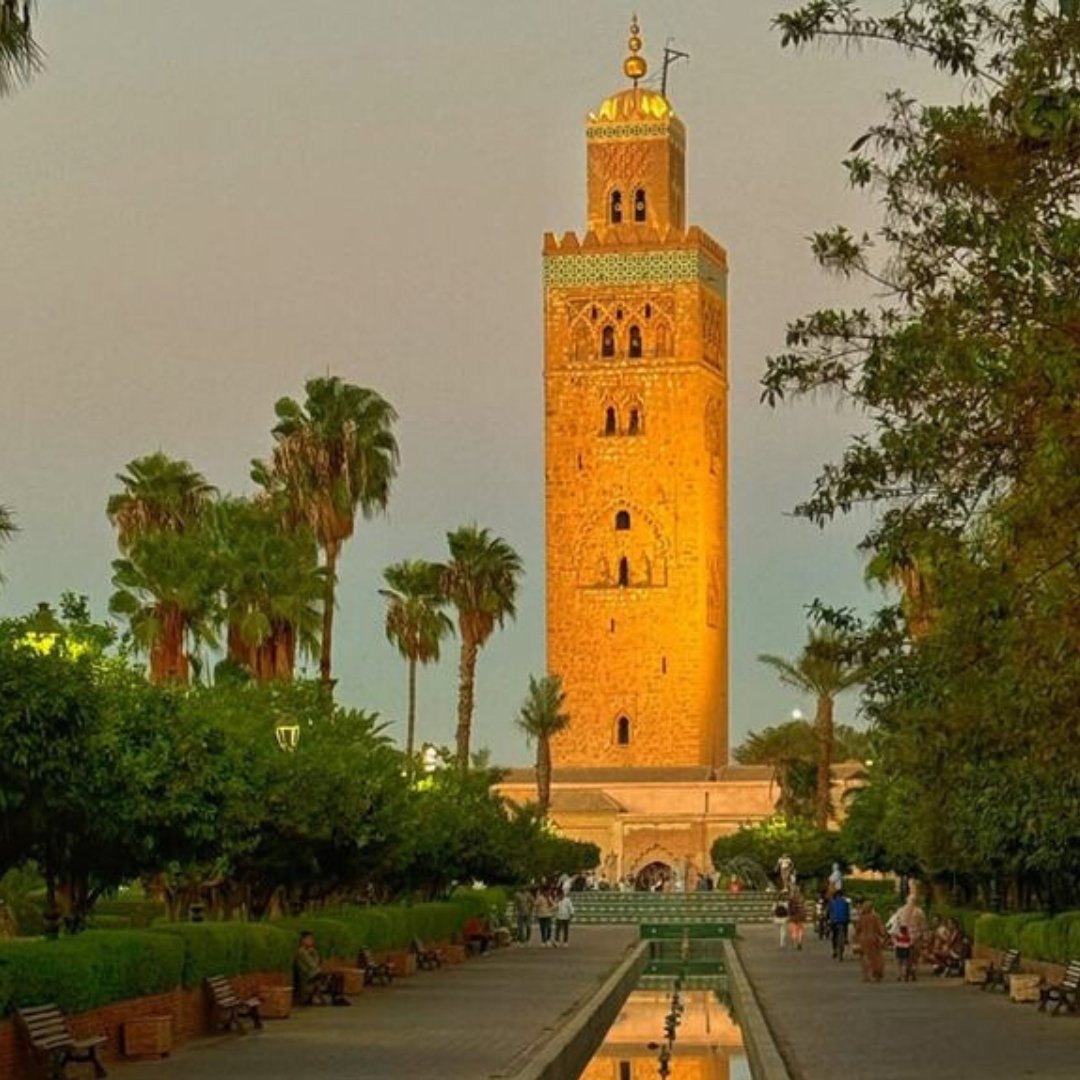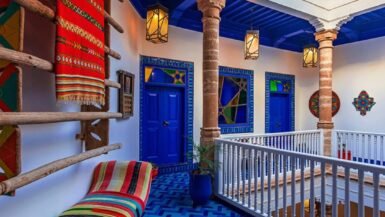The Koutoubia Mosque stands majestically in the heart of Marrakech, with its iconic minaret considered the undisputed symbol of the city and its most important landmark. This comprehensive guide will take you on a journey to explore the rich history of the Koutoubia Mosque, its unique architecture especially the famous Koutoubia minaret, its strategic location near Jemaa el-Fna Square, as well as practical information about visiting the Koutoubia Mosque and important access rules you should know before visiting this unique historical monument in Marrakech.
Table of Contents
History of the Koutoubia Mosque: From Two Mosques to an Icon
The history of the Koutoubia Mosque’s construction dates back to the beginning of the Almohad dynasty era, and witnessed two successive constructions before reaching its current form. This magnificent mosque represents one of the most important religious and architectural monuments of Islamic civilization in North Africa, and had a significant influence on architecture in Morocco and other cities like Rabat and Fez.
Construction of the First and Second Mosque in the Almohad Era
The construction of the Koutoubia Mosque began in the mid-12th century, specifically during the reign of Almohad Caliph Abd al-Mumin ibn Ali around 1147 AD. Interestingly, the Almohads built two mosques at the same site, as it turned out that the first mosque was not precisely oriented toward the Qibla (direction of Mecca), which necessitated building a second mosque next to it, perfectly aligned with the Qibla.
Development work on the mosque continued during the reign of Yacoub al-Mansour (1184-1199), who completed the construction of the famous minaret that became the symbol of both the mosque and the entire city. Under Almohad rule, the mosque acquired great religious and political importance, being a center of worship and education in the empire’s capital at that time, and was connected to Sufi zawiyas, especially the Qadiriya Zawiya which played an important role in spreading Islamic education.
Why Is It Called “Koutoubia”?
The name “Koutoubia” comes from the Arabic word “al-Kutubiyyin,” which means “booksellers.” The mosque acquired this name because the surrounding area housed markets specialized in selling manuscripts and books, which became part of the traditional Marrakech souk. In the 12th century, this area was an important center of science and culture, where booksellers, scribes, and scholars gathered around the mosque, creating a site for intellectual and cultural exchange.
Architecture of the Koutoubia Mosque: The Art of the Almohad Minaret and Mosque
The architecture of the Koutoubia Mosque, especially its famous minaret, constitutes a remarkable example of the Almohad architectural style that influenced the region and extended its impact to Andalusia and the entire Maghreb. This architectural influence can be observed in many historical buildings such as Ben Youssef Madrasa and El Badi Palace, which harmonizes with traditional Moroccan cuisine and traditional products in an integrated cultural framework.
The Koutoubia Minaret: Its Design and Height
The Koutoubia minaret is distinguished by its imposing square shape and majestic height of approximately 77 meters (253 feet), including the upper lantern. The minaret was built from the region’s characteristic red sandstone, giving it a warm color that shines particularly at sunset, and can be seen from the historic ramparts and city gates.
This minaret is considered one of the most important architectural achievements of the Almohad dynasty, and became a model that inspired the construction of other famous minarets such as Hassan Tower in Rabat and the Giralda in Seville, Spain. For more information about Moroccan architectural heritage, you can visit the International Council on Monuments and Sites website.
Minaret Decorations
The four facades of the minaret feature complex and varied geometric decorations, with each facade bearing a unique design. These decorations include:
- Interlaced blind (non-pierced) arches
- Network-shaped geometric patterns (Sebka decoration)
- Beautiful Islamic calligraphic inscriptions
- Horizontal decorative bands dividing the facade into levels
The decorations become more complex as we ascend toward the top of the minaret, in a unique architectural style that combines simplicity and complexity simultaneously, reflecting the development achieved by handicrafts and traditional products in that era.
Interior Stairs
One of the distinctive features of the Koutoubia minaret is that it contains no traditional stairs, but interior ramps. This unique system was designed to allow horseback ascent to the top, a feature shared with Hassan Tower in Rabat and the Giralda in Seville which were built later on the same pattern.
The Mosque Building Itself
The mosque consists of a large columned prayer hall (hypostyle style), in addition to a spacious courtyard (patio). The Koutoubia Mosque is one of the largest mosques built by the Almohads in their era, capable of accommodating thousands of worshippers.
The Almohad architectural design is characterized by simplicity in general form and complexity in surface decorations, with the use of horseshoe arches characteristic of Moroccan Islamic architecture, which are also found in the Bahia Palace and other monuments in the city.
Importance of the Koutoubia Mosque: Religious, Historical and Architectural Symbol
The Koutoubia Mosque holds multifaceted importance:
From a religious perspective, it is considered the largest and most important mosque in Marrakech, and remains an active place of worship for Muslims to this day.
Historically, it represents one of the main monuments of the powerful Almohad dynasty, reflecting their architectural ambitions and religious authority. It symbolizes the golden age of Marrakech as the capital of a powerful Islamic empire that extended across North Africa and parts of the Iberian Peninsula.
Architecturally, the Koutoubia minaret constituted an original model for other famous minarets in Morocco and Andalusia, such as Hassan Tower in Rabat and the Giralda in Seville. It is considered a model of Almohad architectural art that blends simplicity and complexity. To learn more about world heritage, you can visit the official UNESCO website.
As an urban landmark, the minaret represents the most famous reference point on Marrakech’s skyline, and a symbol of the city used for orientation and navigation.
Due to its exceptional importance, the Koutoubia Mosque has been inscribed as part of the UNESCO World Heritage site “Medina of Marrakech.”
Visiting the Koutoubia Mosque: Practical Guide and Access Rules
The Koutoubia Mosque is one of the monuments that must be seen when visiting Marrakech, but it’s important to know its specific access rules to properly plan your visit. When planning your stay in Marrakech, it’s recommended to book accommodation near the medina to make the most of visiting historical monuments.
Mosque Access for Non-Muslims
Please note that access to the main building of the Koutoubia Mosque (the prayer hall) is restricted to Muslims only. This is an important rule that must be respected when visiting this religious monument.
However, non-Muslims can walk around the mosque and enjoy viewing the magnificent minaret from outside, and stroll in the gardens surrounding it. These surrounding areas offer superb views of the minaret from different angles, and are considered the best places to take souvenir photos.
Access for Muslim Worshippers
For Muslims, the Koutoubia Mosque is an active place of worship, where the five daily prayers are performed. Muslim visitors can enter the mosque to pray while respecting prayer times and mosque etiquette.
Mosque Location and How to Get There
The Koutoubia Mosque is located in the heart of Marrakech, just a few steps west of the famous Jemaa el-Fna Square. It can be easily accessed on foot from the square or from surrounding neighborhoods.
Due to the distinctive height of its minaret, the mosque constitutes an important landmark for getting around the city, visible from most parts of the old city. For tourists, they can use map applications or follow the directional signs available in the city to reach it.
Best Time for Visit and Observation
It is recommended to visit the Koutoubia Mosque during the day to get a clear view of the minaret and its architectural details. However, afternoon time and sunset offer magnificent golden lighting on the minaret, making it an ideal time to take exceptional photos.
It’s better to avoid visiting just before prayer times or during them, out of respect for the faithful who flock to the mosque at these times.
Respecting the Sacred Nature of the Place
Although non-Muslims cannot enter the mosque, it is advised to wear modest clothing when visiting the surrounding area (covering shoulders and knees) as a sign of respect.
Please maintain quiet when near the mosque, especially during the call to prayer or prayer times. When taking photos, it’s preferable to ask permission from people before photographing them, especially worshippers.
It should be noted that viewing the mosque from outside and entering the surrounding gardens is completely free.
Gardens and Areas Surrounding the Koutoubia Mosque
Beautiful gardens and green spaces known as “Koutoubia Gardens” surround the mosque, providing shaded places to sit and enjoy viewing the minaret. These gardens constitute an ideal place to relax and meditate away from the city’s hustle and bustle, and offer an experience similar to what we find in the famous Majorelle Gardens and Menara Gardens in the city.
The mosque’s strategic location near Jemaa el-Fna Square makes it an ideal starting point for exploring other monuments in the old city. From here you can easily head to Marrakech’s traditional souks, which begin from the north side of the square.
Other Recommended Monuments to Visit
While in the Koutoubia Mosque area, you can visit many nearby monuments such as the Bahia Palace, El Badi Palace, and Ben Youssef Madrasa. You can also enjoy the experience of traditional Moroccan cuisine in restaurants surrounding the area. To learn more about tourism in Morocco, you can visit the official website of the Moroccan National Tourist Office.
Conclusion: The Koutoubia Mosque… Eternal Symbol of Marrakech
The Koutoubia Mosque represents the most prominent and distinctive monument in Marrakech, it is an architectural masterpiece from the Almohad era and witness to the city’s rich history. Its majestic minaret stands as a reference point on the city’s skyline and in its daily life.
Even without entering the prayer hall, enjoying the view of the Koutoubia minaret and walking in the gardens surrounding it constitutes an essential part of the authentic Marrakech visiting experience. Visiting this historical monument completes the experience of discovering authentic Moroccan culture and enjoying the beauty of Islamic architecture.
We invite you to visit this unique historical monument, and enjoy the beauty of the Koutoubia minaret, while respecting the visiting rules and the religious sacred nature of the place. Share your experience and photos of this iconic monument with your friends, and make sure to visit other nearby monuments such as Jemaa el-Fna Square and Marrakech’s traditional souks.
Do you have other questions about visiting the Koutoubia Mosque or other Marrakech monuments? Share your experience in the comments below!






Leave a reply